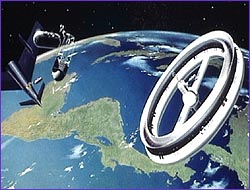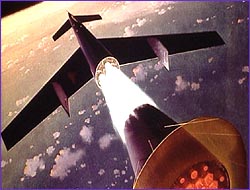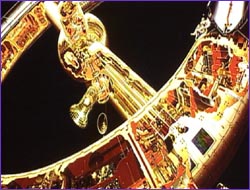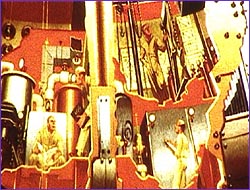 |

|
Inspired by Science Fiction by Gary Westfahl
The first person to offer a blueprint for a functional space station was Russian schoolteacher Konstantin Tsiolkovsky, who designed a cylindrical facility with a greenhouse, laboratory, living quarters, and docking area for spacecraft. His didactic novel Beyond the Planet Earth (1920) remarkably anticipated the ISS by picturing a space station with a crew of six people from Russia, America, France, England, Germany, and Italy, all of which (save for England) are now involved in its construction. In the 1920s, members of the German Rocket Society (GRS) discussed space stations in nonfictional works: Hermann Oberth's The Rocket into Interplanetary Space (1923) introduced the term "space station," while Hermann von Noordung's The Problems of Space Flying (1929) went into detail about space station design and construction. More extravagantly, Englishman J. D. Bernal's short book The World, the Flesh, and the Devil (1929) predicted gigantic spheres in space as future homes for humanity. However, these proposals bore no immediate fruit: In the 1930s and 1940s, Adolf Hitler diverted GRS activities to war preparations, and except for the lonely experiments of American Robert Goddard, people the world over generally displayed no interest in space travel. The writers and readers of American science fiction, devoted as they were to garish magazines filled with space adventures, were the exception. When the magazine Science Wonder Stories republished The Problems of Space Flying, with a striking cover by Frank R. Paul, sci-fi authors got their first taste of space stations, which subsequently became regular elements in their stories. As stopovers for weary space travelers, one space station floated halfway between Earth and Mars, another halfway between the Sun and Alpha Centauri. Murray Leinster's "The Power Planet" (1931) proposed space stations as sources of energy for Earth; Basil Wells's "Factory in the Sky" (1941) demonstrated the potential benefits of space factories; and George O. Smith's "Venus Equilateral" stories (1942-45) featured an inhabited communications satellite. In effect, science-fiction writers critically examined the concept of space stations and concluded that they would be practical and helpful in various ways.
Impressed by the articles in Collier's, science-fiction writers began promoting the space station as a necessary base for further expeditions into space. Novels like Arthur C. Clarke's Islands in the Sky (1952) celebrated the people who built and inhabited space stations, and space stations began to appear in science-fiction films such as Project Moonbase (1953) and Conquest of Space (1955). At the height of the Cold War, works of fiction and nonfiction alike often emphasized the military value of space stations: Vigilant Westerners could establish observation posts and prevent Communists from building orbital launching pads for deadly missiles. However, Cold War tensions of a different sort soon canceled von Braun's plans for a space station. In 1961, after Russians launched the first man into space, U.S. President John F. Kennedy felt the need to announce an impressive goal to re-establish American superiority, and he chose landing on the Moon over constructing a space station.
Such visions of space communities became attractive in the early 1970s, because new evidence indicated that all other worlds in our solar system were barren, lifeless, and ill-suited for human settlements. Scientist Gerard O'Neill, for one, built upon Bernal's and Cole's expansive projections to propose huge space habitats to house human colonies. A typical design was an enclosed cylinder, rotating to simulate Earth gravity by means of centrifugal force, with landscapes and buildings on the interior surface. People, it was argued, might establish utopian communities inside such cylinders that were powered by solar energy and offered unique pleasures like zero-gravity "flying" at the center of the cylinder. Organizations emerged to advocate building a space habitat at one of the five LaGrange points, where the gravitational forces of the Earth and Moon are in balance.
Still, while the facility now under construction (see Astronauts in Hard Hats) may seem unrelated to the spectacular predictions of science fiction, the latter's hold on the popular imagination remains strong. Because the film Mission to Mars (2000) describes a Mars expedition that takes place only two decades from now, the astronauts in the movie should be shown departing from the ISS or an expanded version. Instead, the filmmakers created an entirely different World Space Station with a rotating wheel—exactly the sort of "doughnut in the sky" that Bonestell painted long ago. To many, such a construct still represents the only true "space station." In the future, both space-station realities and space station fantasies will undoubtedly continue to exert a powerful influence on humanity's actual and wishful journeys into space. Gary Westfahl, who teaches at the University of California, Riverside, has written or co-edited ten books on science fiction and fantasy. Images: (1-4) Frederick I. Ordway III Collection at the U.S. Space & Rocket Center Blueprint for a Space Station | Astronauts in Hard Hats Inspired by Science Fiction | Free-Falling | Resources Transcript | Site Map | Stationed in the Stars Home Editor's Picks | Previous Sites | Join Us/E-mail | TV/Web Schedule About NOVA | Teachers | Site Map | Shop | Jobs | Search | To print PBS Online | NOVA Online | WGBH © | Updated November 2000 |
 Artist Chesley Bonestell worked from rocket scientist Wernher von Braun's original designs to paint this view of a space station hovering above Central America, together with a resuable shuttle vehicle, space taxi, and telescope.
Artist Chesley Bonestell worked from rocket scientist Wernher von Braun's original designs to paint this view of a space station hovering above Central America, together with a resuable shuttle vehicle, space taxi, and telescope.
 Nothing illustrated the burgeoning collaboration between space scientists and the creators of science fiction better than the March 22, 1952 issue of Collier's magazine, whose cover was graced by this Bonestell painting of von Braun's three-stage launch vehicle.
Nothing illustrated the burgeoning collaboration between space scientists and the creators of science fiction better than the March 22, 1952 issue of Collier's magazine, whose cover was graced by this Bonestell painting of von Braun's three-stage launch vehicle.
 Collier's artist Fred Freeman painted this cutaway view of von Braun's vision of a doughnut-shaped space station.
Collier's artist Fred Freeman painted this cutaway view of von Braun's vision of a doughnut-shaped space station.
 A detail from Freeman's painting showing astronauts working aboard von Braun's project space station.
A detail from Freeman's painting showing astronauts working aboard von Braun's project space station.